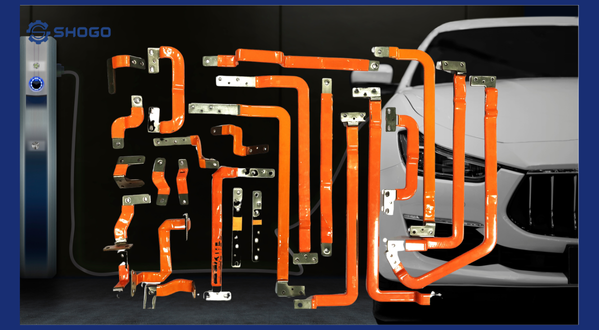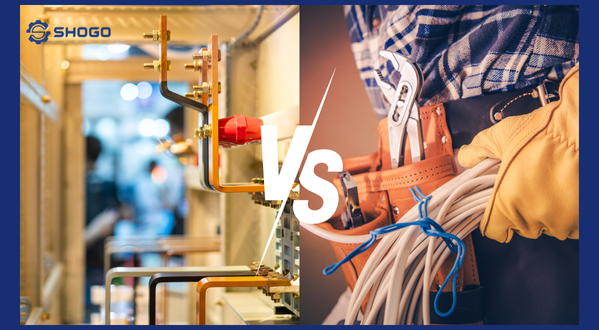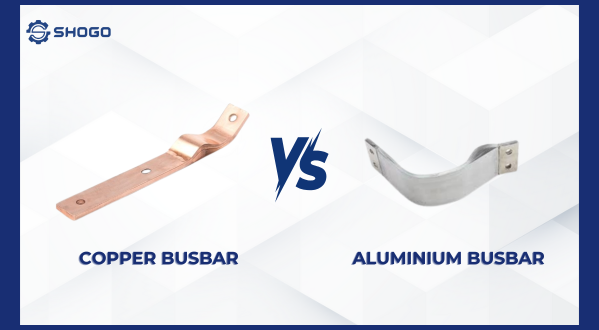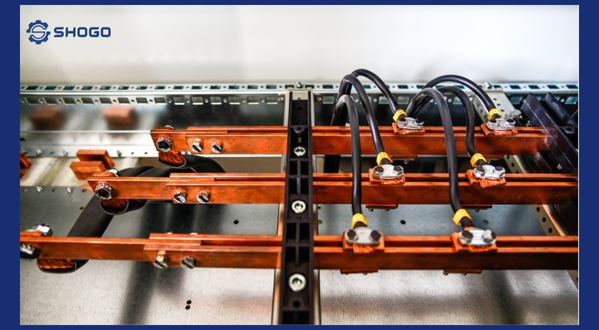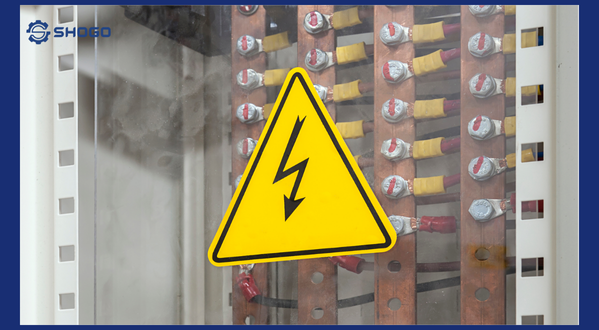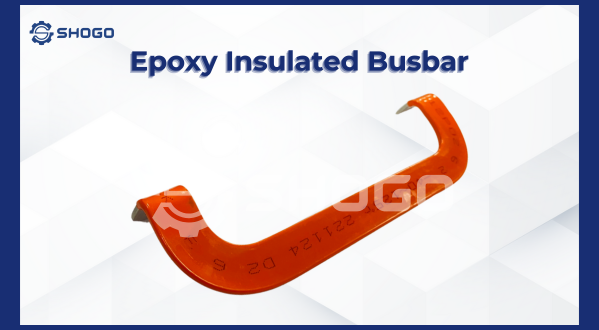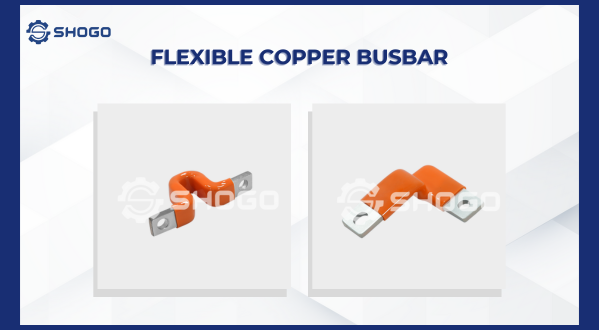
1. What is flexible copper busbar?
Flexible Copper Busbar is a conductive metal bar made from multiple layers of stacked copper foil, each layer ranging in thickness from 0.1 to 1mm. They are manufactured by welding, stamping, plating, forming, insulation, etc. The plating can be tin and nickel. The outstanding feature of flexible copper busbars is the ability to easily bend and shape to fit many different installation spaces.
2. Structure of Flexible Copper Busbar
2.1. Conductive core:
- Made from many small copper strands braided together, creating high flexibility and good electrical conductivity.
- The number of copper wires and the cross-sectional area of the conductive core will depend on the rated current that the busbar needs to conduct.
2.2. Insulation:
- Wraps around a conductive core, which can be made from a variety of materials such as PVC, XLPE, EPR, etc.
- The insulating layer protects the conductive core from corrosion, moisture and ensures user safety.
2.3. Protective cover:
- Made from materials such as PVC, synthetic rubber, or metal, which protects the busbar from external influences such as impact, abrasion, chemicals, etc.
- Protective covers can also help increase the rigidity and durability of the busbar.
2.4. Accessory:
- Includes connectors, clamps, brackets, etc. to help connect the busbar with other electrical equipment and fix the busbar during use.
In addition, Flexible Copper Busbar can also be designed with different special structures to meet specific usage needs, for example:
- Flexible Copper Busbar covered with metal mesh: helps increase the load-bearing capacity and anti-interference ability of the busbar.
- Flexible Copper Busbar are fire resistant: used in environments with high risk of fire and explosion.
- Flexible Copper Busbar are water resistant: used in wet or outdoor environments.
3. Classification of Flexible Copper Busbar
Flexible Copper Busbar are classified according to many different criteria, including:
3.1. According to structure:
- Flexible Copper Busbar covered with metal mesh: there is an additional layer of metal mesh wrapped around the conductive core, helping to increase the load-bearing capacity and anti-interference ability of the busbar.
- Flexible Copper Busbar are fireproof: used in environments with high risk of fire and explosion, with insulation made from fireproof materials.
- Water-resistant Flexible Copper Busbar: used in wet or outdoor environments, with protective cover made from water-resistant material.
3.2. According to the number of conductive core layers:
- Single-layer Flexible Copper Busbar: has a single conductive core layer.
- Multi-layer Flexible Copper Busbar: has many layers of conductive cores stacked on top of each other, helping to increase the busbar’s electrical conductivity.
3.3. By shape:
- Flat Flexible Copper Busbar: flat shape, easy to install in tight spaces.
- Flexible Copper Busbar in round bar shape: have round bar shape, have better bearing capacity than flat bus bars.
- Tube-shaped Flexible Copper Busbar: has a hollow tube shape, helping to reduce weight and increase heat dissipation for the busbar.
3.4. By application:
- Flexible Copper Busbar for electrical cabinets: used in electrical cabinets, compact in size and easy to install.
- Flexible Copper Busbar for transformer stations: used in transformer stations, has high load capacity and high durability.
- Flexible Copper Busbar for electric vehicles: used in electric vehicles, has good vibration and impact resistance.
- Flexible Copper Busbar for elevators: used in elevators, has good bending resistance.
In addition, Flexible Copper Busbar can also be classified according to other criteria such as: size, cross-section, insulating material, protective shell material, etc.
4. Advantage of Flexible Copper Busbar
Compared to traditional types of electrical busbars such as electrical cables, Flexible Copper Busbar offer many outstanding advantages, including:
High flexibility:
- Flexible copper busbars can be easily bent and installed in tight spaces or with many angles, helping to save space and simplify the construction process.
- This flexibility is especially useful in applications that require frequent layout changes or installation in hard-to-reach locations.
Easy installation and connection:
- Flexible copper busbars are designed with specialized connectors, making connection to electrical equipment quick, simple and safe.
- Compared to connecting electrical cables with lead clamps or solder joints, using flexible copper busbars saves significant construction time and effort.
Good electrical conductivity:
- Copper busbars are made from copper, a metal that conducts electricity better than aluminum or other conductive materials.
- Thanks to its good electrical conductivity, flexible copper busbars help minimize power loss on the line, contributing to energy savings and improving electricity efficiency.
Durable:
- Flexible copper busbars are made from high-quality materials, resistant to corrosion, oxidation and other external influences, ensuring a long service life.
- This resilience helps reduce maintenance and bus bar replacement costs during operation.
Safe:
- The insulation and protective cover of the flexible copper busbar helps ensure safety for users when in direct or indirect contact with the busbar.
- Insulating materials used for flexible copper busbars are often fire resistant, helping to reduce the risk of fire and explosion in the electrical system.
Cost savings:
- Using flexible copper busbars can help save construction costs due to quick and simple installation.
- In addition, flexible copper busbars also help save energy thanks to their good conductivity, contributing to reducing electricity bill costs.
Beauty:
- Flexible copper busbars have a modern, highly aesthetic design, contributing to enhancing the value of the project.
- Compared to traditional types of electrical busbars such as electric cables, flexible copper busbars bring a neater, more luxurious appearance to the electrical system.
In addition, Flexible Copper Busbar also have a number of other advantages such as:
- High temperature resistance
- Vibration and impact resistance
- Ability to resist electromagnetic interference
- Easy to repair and maintain
Overall, flexible copper busbars are an efficient, safe and economical electrical conduction solution for a variety of applications.
5. Application of Flexible Copper Busbar
In the electricity industry:
- Electrical cabinets: Flexible copper busbars are widely used in electrical cabinets to distribute power from the main source to other electrical equipment in the cabinet.
- Substation: Flexible copper busbars play an important role in connecting transformers, circuit breakers, capacitors and other electrical equipment in the substation.
- Power plant: Flexible copper busbars are used to conduct electricity from the generator to the substation and then distribute the electricity to other areas in the plant.
- High-voltage power systems: Flexible copper busbars are used in high-voltage power systems to transmit power over long distances.
In industry:
- Industrial machinery and equipment: Flexible copper busbars are used to supply power to motors, machinery and other industrial equipment.
- Robot: Flexible copper busbars are used to supply power to the robot’s joints and actuators.
- Electric Vehicles:Flexible copper busbars are used to connect batteries to electric motors and other electrical components in electric vehicles.
- Elevator: Flexible copper busbars are used to supply power to the elevator’s motor and control system.
In the construction industry:
- Building’s electrical system: Flexible copper busbars are used to distribute power from the main source to apartments, offices and other areas in the building.
- Elevator system: Flexible copper busbars are used to supply power to the elevator’s motor and control system.
- Ventilation system: Flexible copper busbars are used to supply power to fans and other equipment in the ventilation system.
In the telecommunications industry:
- Transceiver station: Flexible copper busbars are used to connect the antennas and other electrical equipment in the transceiver station.
- Fiber optic systems: Flexible copper busbars are used to supply power to optical amplifiers and other devices in fiber optic systems.
Other applications:
- Marine industry: Flexible copper busbars are used on ships to supply power to motors, electronics and other equipment.
- Aviation industry: Flexible copper busbars are used on aircraft to supply power to engines, electronics and other equipment.
- Medical industry: Flexible copper busbars are used in medical equipment such as X-ray machines, MRI machines and CT machines.
6. Some notes when using flexible copper busbars
Select:
- Choose a busbar of the appropriate size for the current needs and application.
- Consider the maximum operating temperature of the busbar and ensure it is suitable for the usage environment.
- Choose busbars with rust and corrosion resistance appropriate to the installation environment.
- Choose a reputable supplier to ensure product quality.
Installation:
- Follow the manufacturer’s installation instructions.
- Make sure all connections are tight and secure.
- Use appropriate tools to avoid damaging the busbar.
- Avoid letting the busbar come into direct contact with heat sources.
- Bend the busbar carefully to avoid breaking or cracking.
Safe:
- Disconnect power before installing or maintaining the busbar.
- Wear appropriate labor protection equipment when working with busbars.
- Do not touch the busbar while there is power.
- Regularly check busbars for damage and replace when necessary.
Besides:
- Flexible copper busbar connectors should be used to ensure safe and secure connections.
- Silicone glue or electrical tape can be used to fix the busbar.
- The busbar should be routed through conduit or cable tray to protect it from environmental influences.
- Store the busbar in a cool, dry place.
7. Conclusion
Flexible Copper Busbar are a flexible and effective solution for electrical systems, bringing many outstanding benefits compared to traditional busbars. Thanks to its flexibility, high conductivity, high durability and ease of installation, Flexible Conductors are increasingly widely used in many different fields.





